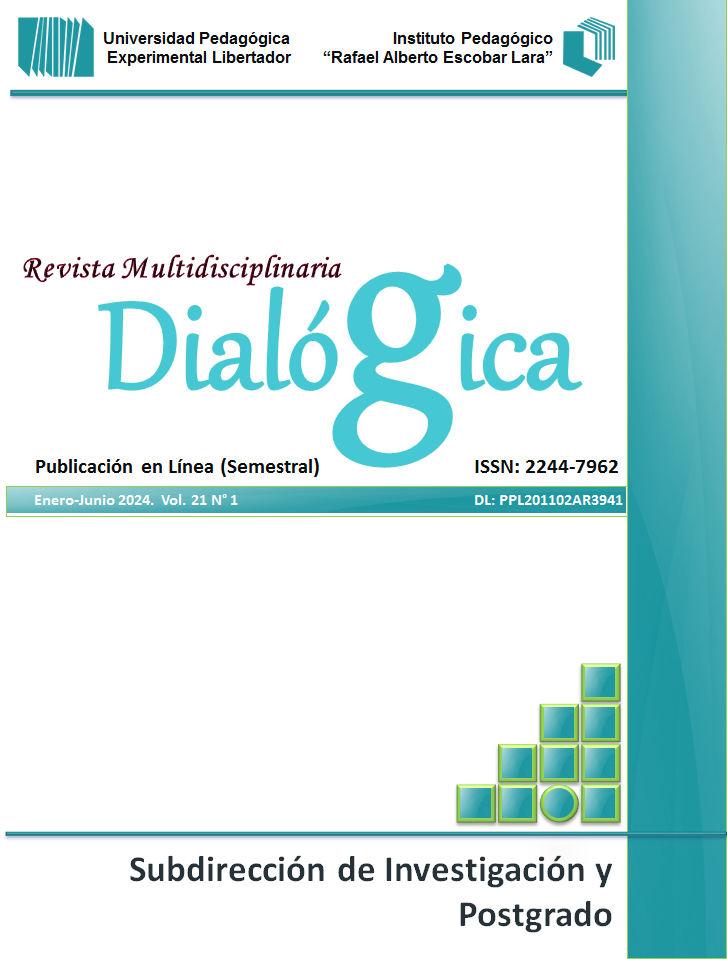SANTO SEPULCRO DE VILLA DE CURA: MANIFESTACIÓN CULTURAL DEL ESTADO ARAGUA
DOI:
https://doi.org/10.56219/dialgica.v21i1.2880Palabras clave:
Sepulcro, Manifestación Cultural - Religiosa, Devotos, FeResumen
Las manifestaciones culturales de índole religioso presentes en una localidad se basan en una distinción notoria de creencias y prácticas que fundamentan el acervo histórico vivencial de un espacio geográfico, creando así un paisaje de interculturalidad en la población, y ese es el caso de la localidad de Villa de Cura, Estado Aragua (Venezuela), con la procesión del Santo Sepulcro, caracterizada por su capacidad de movilizar devotos todos los viernes de cada Semana Santa. El propósito de este artículo es describir esta manifestación religiosa – cultural desde algunos documentos y la historia de vida de uno de los cargadores del Santo. Según Malinowski (1984) la Cultura es el “Conjunto integral constituido por los utensilios y bienes de los consumidores, por el cuerpo de normas que rige los diversos grupos sociales, por las ideas y artesanías, creencias y costumbres” (p.56). Todas estas características las reúne esta expresión cultural - religiosa aragüeña.
Citas
Chárriez, M. (2012). Historias de Vida: Una metodología de investigación cualitativa. https://www.uv.mx/psicologia/files/2017/12/historias_de_vida_una_metodologia_de_investigacion_cualitativa.pdf
Ferrarotti, F. (1990). La Historia y lo Cotidiano. https://docplayer.es/208055075-La-historia-y-lo-cotidiano.html
Gaarder, J. (1991). El Mundo de Sofía. Oslo: Siruela.
González, H. (2022). Santo Sepulcro de Villa de Cura: 204 años de devoción y tradición.https://elsiglo.com.ve/2022/04/08/santo-sepulcro-villa-de-cura/
La Santa Biblia, tr. 1988.
Malinowski, B. (1984). Una Teoría Científica de la Cultura. Sarpe.
Morillo, J. (2016). Santo Sepulcro de Villa de Cura. https://steemit.com/spanish/@jennimorillo/santo-sepulcro-de-villa-de-cura#:~:text=Sobre%20el%20origen%20de%20la,esperaban%20en%20Villa%20de%20Cura
Ley Orgánica de Cultura. (2014). https://albaciudad.org/wp-content/uploads/2014/12/Gaceta-Oficial-Extraordinaria-N%C2%BA-6.154-LOC.pdf
Descargas
Publicado
Cómo citar
Número
Sección
Licencia
Derechos de autor 2024 Pastor Eduardo Carmona Blanco, Rolando Antonio García Hernández

Esta obra está bajo una licencia internacional Creative Commons Atribución-NoComercial-CompartirIgual 4.0.


 @revistadialogica
@revistadialogica DialogicaUPEL
DialogicaUPEL RevistaDialogicaUPELMaracay
RevistaDialogicaUPELMaracay dialógicaupel@gmail.com
dialógicaupel@gmail.com dialogicaupel.blogspot.com
dialogicaupel.blogspot.com https://issuu.com/dialogicaupel
https://issuu.com/dialogicaupel https://revistas.upel.edu.ve/index.php/dialogica/
https://revistas.upel.edu.ve/index.php/dialogica/










